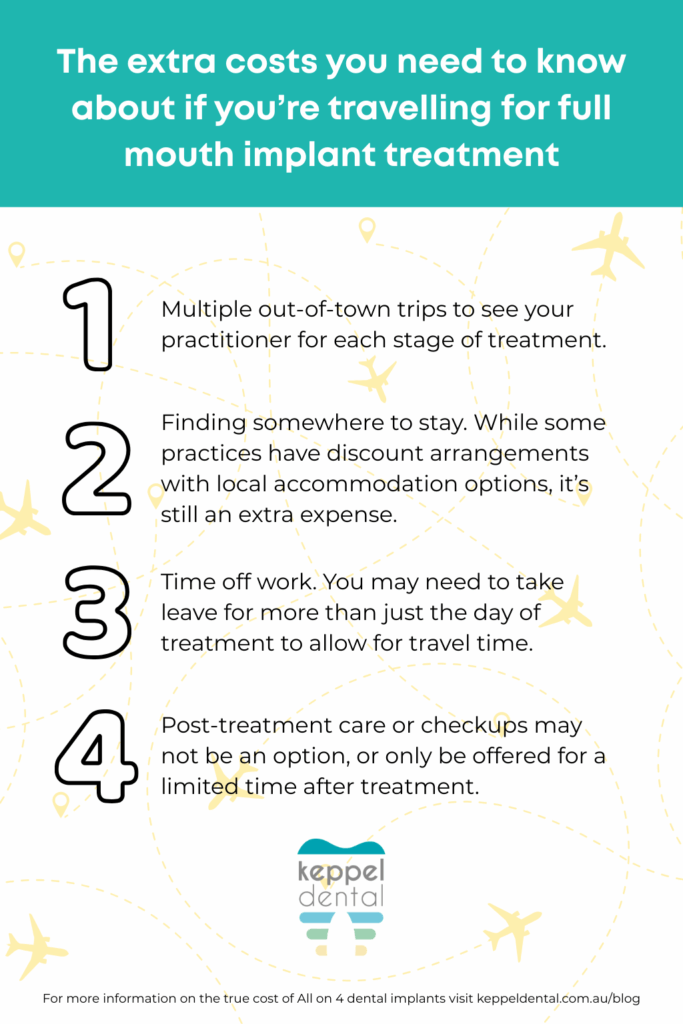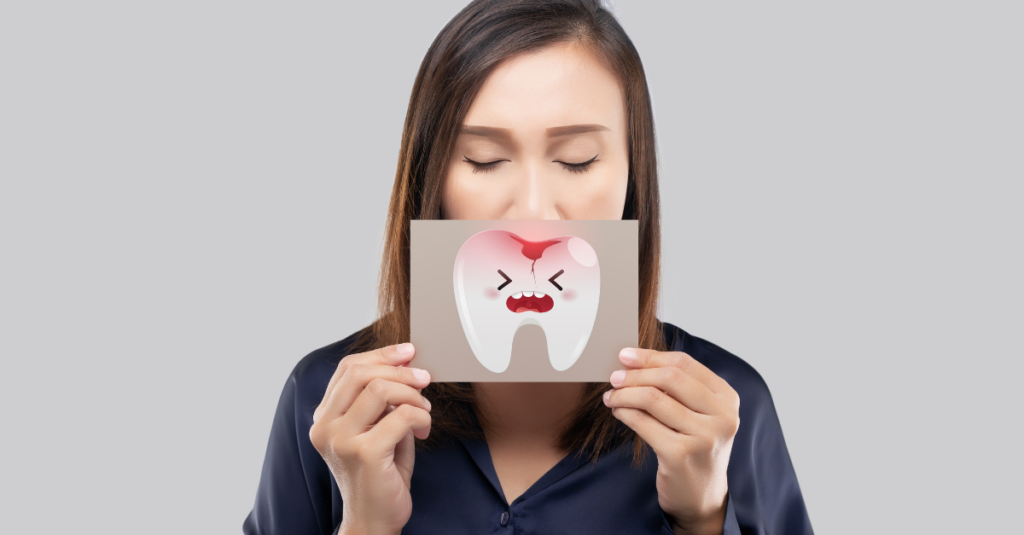Turning the idea of getting full-mouth (All on 4, or Ao4) dental implants into reality can take months, if not years. Taking the time to plan and save up for the procedure is part of the journey. And when it comes to how much you’ll need to save, well… that depends on where you go for your treatment.
Dental practitioners in Australia set costs that reflect:
- their location
- their experience
- the price of the materials they use.
So when you see one fee that’s several thousand dollars less than another, why wouldn’t you choose the more affordable option?
I completely get it. But (and there’s nearly always a ‘but’) there’s a recurring theme I hear from patients who have chosen the more affordable All on 4 option.
The cheaper treatment didn’t save them as much as they thought it would.
There are a number of reasons why people end up feeling this way, which I’ll get into later. But right now, I want to share some of their general concerns and experiences so you can make a fair call on whether travelling intrastate, interstate or internationally will leave you and your oral health better off.

How much All on 4 treatment costs in Australia
Dental practices in Australia are independent, private businesses. And like any independent business, each practice sets its own fees. So the cost of getting full mouth dental implants in Australia varies widely from practice to practice and state to state.
Using data from the latest ADA fees survey from 2022, the lowest cost for full mouth implants is $19,311 and the highest is $52,312. That’s quite a range.
To help us understand All on 4 fees—and the costs of other common dental work—the Australian Dental Association (ADA) runs a fee survey every few years. This gives us the lowest and highest dental costs in Australia for different treatments, as well as the mean fee for each one.
Using data from the latest ADA fees survey from 2022, we’ve worked out that the lowest cost for full-mouth implants is $19,311.54 and the highest is $52,312.52. (Here’s how we got to these figures.) That’s quite a range. And these figures account only for the cost of the components and procedures most commonly needed for Ao4 treatment. These include:
- a comprehensive exam (intraoral x-rays and/or OPG, CBCT scan, photos and digital modelling)
- pre-treatment consultation
- surgery to place the 4-6 implants needed
- the final bridge.
Keppel Dental sits somewhere in the middle. We charge $25,000 for an upper or lower arch. But this is just an estimate. Your treatment may be more or less depending on:
- how many x-rays you need
- any extra consultations you need before or after treatment
- whether you need additional surgical procedures such as
- tooth extraction
- bone grafting
- a sinus lift
- gum grafting
- whether you need a temporary bridge or arch.
If you already know how full-mouth implants are fitted, you’d probably expect to see these items on your treatment bill. But the path to getting dental implants isn’t the same for everyone.

Personal treatment plans are essential to understanding the total cost of full-mouth dental implants. And 6 factors affect the fee.
- Your current oral health. Implant success relies on a healthy mouth and gums. Any signs of poor mouth health (inflamed or bleeding gums, cavities, etc.) must be addressed first.
- Extra dental work. This could involve extracting existing teeth to make room for your implants, a sinus lift for top-tooth implants, or a lower jaw bone graft for bottom-tooth implants.
- The number of implants being fitted. This will depend on whether you’re having a full arch, partial bridge, just the top, just the bottom, or implants in both top and bottom.
- Implant size and placement. Implants come in different lengths and diameters. The size of the implant depends on the amount of bone available and the distance between the teeth.
- The implant’s manufacturer. Australia has several dental implant manufacturers. And each company delivers its own take on implants. Some invest more in research and manufacturing than others, which leads to higher quality at a higher price.
- The location and experience of your dentist. The practice’s overheads and the dentist’s ongoing specialist training to keep up with changing technologies may be reflected in the price of implants and other services.
Travelling for implant treatment packs its own costs
Where you go for treatment is an important cost comparison factor. Whether it’s in the city or the country, in Australia or overseas, the size of the economy the practice is working in affects how much the dentist charges.
For example, dentists working in countries with smaller economies won’t have the same overheads as those operating in larger ones. This is why you can often get lower rates by travelling to one of Australia’s major cities or trying overseas dental tourism.
But this doesn’t always work out well for patients. While the cost of the treatment itself may be lower, there are additional charges and potential challenges you need to consider.

Travelling there, back, and possibly there again (and again)
It takes multiple appointments to properly complete full-mouth implant treatment. Even if your first consultations aren’t face-to-face, and records and x-rays are forwarded on, you’ll still need at least two trips. And that’s assuming yours is a simple case (i.e. you don’t need any extra dental work before implants, and you don’t have any complications afterwards).
So when budgeting for these locations, factor in multiple airfares and airport parking. You may also need to budget for taxis or car hire to get around.
Sorting somewhere to stay
Lobbing in with family or friends who live near your chosen practice is ideal. Being somewhere familiar can make recovery more comfortable, not to mention the extra TLC you’ll get if you’re feeling below par afterwards.
But if staying with someone you know isn’t an option, you’ll need to find a hotel or apartment. It’s always worth asking the practice’s client care coordinator if they offer an accommodation subsidy. Practices that want to attract out-of-town patients commonly have arrangements with local hotels, motels and apartments. Using these offers will save you money, but you’ll be limited to the accommodation options they’ve partnered with.
Arranging time off work
You’ll probably need to use some of your work leave, particularly on the day of your treatment, as it’s not advisable to travel long distances or fly that day.
Most people feel well enough to travel and return to work the day after surgery. However, you might want to add a bit of buffer time to account for:
- any stumbling blocks with your treatment
- you feel worse than you expected
- you encounter travel delays.
The big one: getting post-treatment care

If an implant is doomed to fail, it will happen in the 24-72 hours after treatment. Ideally, you want to be close to your dentist so you can see them quickly.
Patients who travel for treatment and return home quickly afterwards struggle with this. They may have to wait days or even weeks before seeing their practitioner again, by which time the implant is lost. It’s usually at this point that these patients come to me, needing help with one or more of these common dental implant complaints.
- They’re experiencing discomfort in their mouth.
- The implants feel tight or sore.
- They’ve noticed the implanted teeth are coming loose.
- At least one implant has fallen out.
Travelling back to see their original practitioner is no longer an option. They didn’t account for the extra cost or time needed, and they can’t see the dentist until a much later date. This can leave patients feeling lost and confused about what to do.
I can’t emphasise enough how important the post-care treatment stage is. It shouldn’t be overlooked. And from my experience, patients feel confident and secure when they know their dentist is an hour or less away.
Delivering full-mouth dental implant treatment and care in Central Queensland
Getting dental implants isn’t something you decide on a whim. Treatment costs, expected outcomes and time needed all need to be understood, evaluated and planned for before hitting ‘Go’.
Whether you’re at the start of your dental implant journey or ready to take the next step, Keppel Dental can help. Using the latest digital dentistry technologies and high-quality dental implant products, we can deliver the best dental implant care possible for patients in Central Queensland and beyond.
For all the details about organising your treatment with us, head over to our dedicated (and highly-detailed) All on 4 service page.
Working out the cost of All on 4 treatment in Australia
To calculate the costs of Aon4 treatment in Australia, we used the ADA Fee Survey from 2022. But as this treatment has so many variables, we created a simple case scenario.
- The patient is having an implant bridge to replace 14 teeth.
- They’re having 6 implants/abutments, meaning 8 pontics for bridging.
- They need 4 teeth removed using line item 311 only. (The other 2 teeth where the implants will go were previously removed due to decay.)
Using the lowest, highest and mean cost of each line item in the ADA Fee Survey, we then calculated a cost range.
Note: These aren’t perfect numbers, as the fee survey didn’t include fees for some services often associated with Ao4 implants such as:
- CBCT scan
- extra photos and digital modelling offered (depending on the available technology within the practice)
- bone grafting
- sinus lift
- gum grafting.